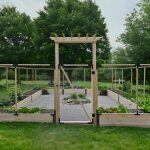
Once you’ve chosen a site for your edible garden, there are many paths you can take in terms of choosing materials, size, and layout. In this article, we’ll give an overview of the pros and cons of different raised bed garden designs – so you can plan a garden that’s with your needs and preferences in mind.
Choosing Materials for Raised Bed Gardens
The material a raised bed is made of is a practical decision as well as an aesthetic one.
Wooden is our first choice for building raised beds. One of the main reasons we use wood is because it is easy to customize and build off of; including structures like fences and trellises. It’s also repairable. Cedar and hemlock contain natural resistance to decay and insects, which will extend the life of your bed. You can treat wooden boards with a food-safe stabilizer to prevent UV damage and water intrusion. This can double the uselife life of your raised beds.
If you prefer natural-looking raised beds without wood, stone is a durable option. This includes rocks, bricks, and concrete. However, stone can be harder to build with. Stone also retains more heat than wood: leading to warmer soil that can heat up the roots of tender young plants, affecting long-term health and growth.
Store bought, metal raised bed kits are a popular option but this metal will warp and rust over time. Most of the time these kits come apart at the screws before the metal decays. Remember, the bed system is only as strong and durable as its weakest link!
Choosing the Best Size For Your Garden
The material a raised bed is made of is a practical decision as well as an aesthetic one.
Wooden is our first choice for building raised beds. One of the main reasons we use wood is because it is easy to customize and build off of; including structures like fences and trellises. It’s also repairable. Cedar and hemlock contain natural resistance to decay and insects, which will extend the life of your bed. You can treat wooden boards with a food-safe stabilizer to prevent UV damage and water intrusion. This can double the uselife life of your raised beds.
If you prefer natural-looking raised beds without wood, stone is a durable option. This includes rocks, bricks, and concrete. However, stone can be harder to build with. Stone also retains more heat than wood: leading to warmer soil that can heat up the roots of tender young plants, affecting long-term health and growth.
Store bought, metal raised bed kits are a popular option but this metal will warp and rust over time. Most of the time these kits come apart at the screws before the metal decays. Remember, the bed system is only as strong and durable as its weakest link!
Finding the Best Garden Layout
Fencing plays a crucial role in determining the layout of your garden. Its primary function is to thwart critter intrusion, while also being a key aesthetic consideration.
Understanding the specific animals you’re dealing with is essential. For larger pests like deer and groundhogs, a fence of at least 5-6 feet with a gate is typically a necessity; which creates a walk-in space. In a gated, fenced-in garden, maximum growing space can be achieved by planting around the perimeter with a central pathway, although it is not the only way.
To deter most rabbits, cats & dogs, a 24 to 36″ fence can suffice. The added benefit of only needing a small fence is that you can build fences on beds to be reached over, leaving your bed layout and design flexible versus a walk-in space.
However, for tighter spots like those nestled next to a patio, single-line placement of raised beds fit into the space can also work. Nonetheless, enclosing narrow spaces with critter-proof fencing poses its own set of challenges. Unless your entire yard boasts a fence that is pest proof or you live in a city yard that doesn’t see groundhogs or deer, pest pressure might still be a concern without a fence.. Achieving a successful no-fence backyard garden is a rare feat, usually reserved for rooftop or city yards with minimal instances of pest pressure.
Designing a great vegetable garden involves thoughtful consideration of materials, size, and layout. By thoughtfully integrating durable materials, manageable layouts, and accessible features, you can cultivate a thriving and enjoyable home garden that yields bountiful harvests season after season!






